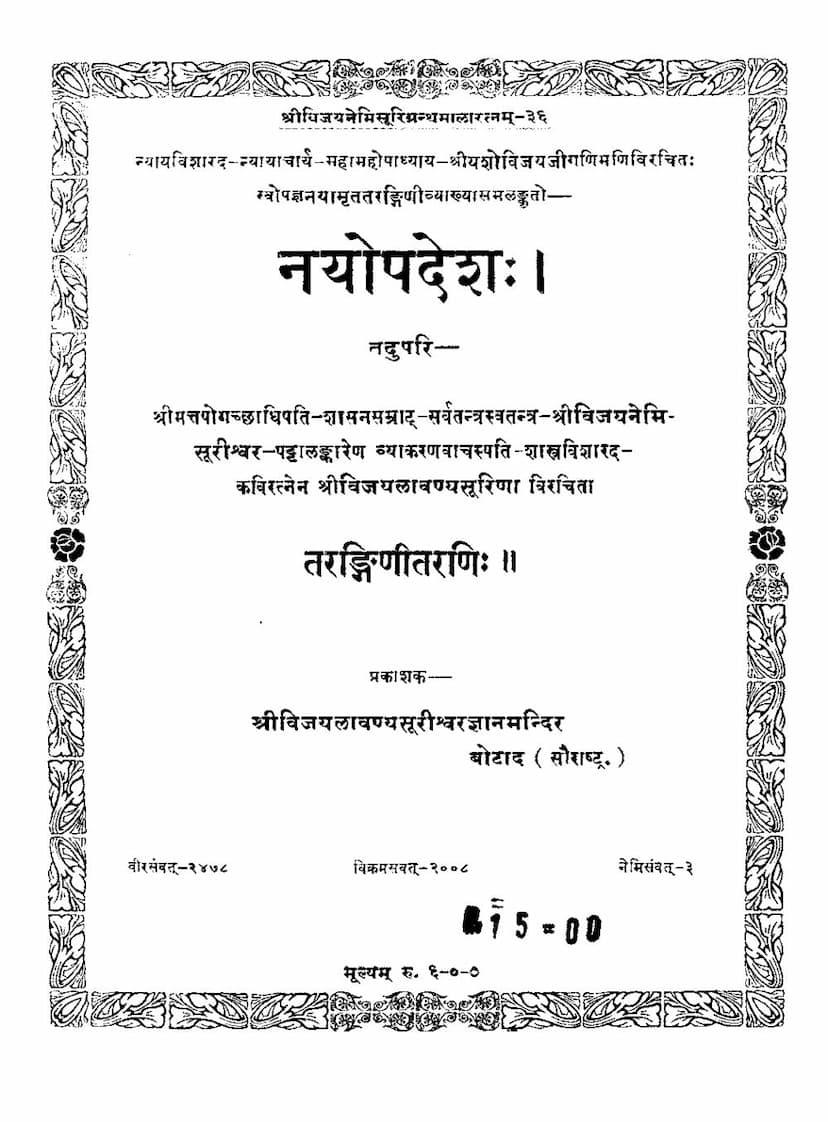Nayopadesha Part 1
Added to library: September 2, 2025

Summary
Certainly! Here is a comprehensive summary of "Nayopadesha Part 1," a Jain text authored by Yashovijay Upadhyay and Lavanyasuri, published by Vijaylavanyasurishwar Gyanmandir Botad. This summary is based on the provided text and catalog link.
Nayopadesha Part 1: A Comprehensive Summary
Book Title: Nayopadesha Part 1 Author(s): Yashovijay Upadhyay, Lavanyasuri Publisher: Vijaylavanyasurishwar Gyanmandir Botad Catalog Link: https://jainqq.org/explore/008444/1
Overview:
"Nayopadesha Part 1" is a significant Jain philosophical text that delves into the intricacies of the "Naya" (standpoints or perspectives) and related concepts within Jain logic. The original work, "Nayopadesha," was authored by the renowned Jain philosopher and logician Yashovijay Upadhyay. This particular edition is enriched with a commentary named "Tarangini Tarani" by Lavanyasuri, who is presented as a prominent figure in the Tapogachha lineage and a scholar of grammar and scriptures. The publication is a testament to the dedication of the Vijaylavanyasurishwar Gyanmandir Botad in preserving and disseminating Jain philosophical knowledge.
Key Concepts and Themes:
The text meticulously explains fundamental Jain logical principles, primarily focusing on:
-
Naya (Standpoints): The core of the work lies in explaining the concept of Naya, which refers to different but valid perspectives through which reality can be understood. The text emphasizes that Nayas are essential for a nuanced and comprehensive understanding of reality, as no single perspective can encompass the entirety of truth.
- Saptanga Naya (Sevenfold Standpoints): The book is expected to discuss the sevenfold classification of Nayas, a cornerstone of Jain logic, which includes:
- Naigama: The synthetic or general standpoint.
- Sangraha: The abstract or universal standpoint.
- Vyavahara: The conventional or practical standpoint.
- Rijusutra: The momentary or temporal standpoint.
- Shabda: The linguistic or grammatical standpoint.
- Abhisamruddha: The grammatical refinement or precise usage standpoint.
- Evambhuta: The standpoint focused on the specific function or essence at a particular time.
- Dravyarika Naya: The standpoint focusing on the substance or eternal aspect of reality.
- Paryayika Naya: The standpoint focusing on the modes or transient aspects of reality.
- The text explores how these Nayas, while seemingly contradictory, are complementary and reveal different facets of the same ultimate reality.
- Saptanga Naya (Sevenfold Standpoints): The book is expected to discuss the sevenfold classification of Nayas, a cornerstone of Jain logic, which includes:
-
Saptabhangi (Sevenfold Predication): Closely related to Naya is the doctrine of Saptabhangi, the sevenfold system of predication used to describe any given reality from multiple Naya perspectives. The text likely elaborates on these seven predication categories:
- Syād-asti (It exists)
- Syād-nāsti (It does not exist)
- Syād-asti-nāsti (It exists and does not exist)
- Syād-avaktavya (It is indescribable)
- Syād-asti-avaktavya (It exists and is indescribable)
- Syād-nāsti-avaktavya (It does not exist and is indescribable)
- Syād-asti-nāsti-avaktavya (It exists, does not exist, and is indescribable) The text emphasizes that Saptabhangi is a method of description that acknowledges the multi-sided nature of reality, preventing dogmatism and fostering a deeper understanding.
-
Naya Pramana Vakyas (Naya and Pramana Statements): The distinction between statements based on Naya (relative truths) and Pramana (absolute truths) is likely discussed. While Nayas provide partial truths from specific standpoints, Pramana offers a complete and ultimate understanding.
-
Anupapatti (Inconsistencies/Contradictions): The text likely addresses and resolves apparent contradictions that arise when applying different Nayas or when interpreting statements from a limited perspective. It aims to show how these apparent contradictions are reconciled within the broader framework of Jain logic.
-
Commentary (Tarangini Tarani): The commentary by Lavanyasuri is crucial for understanding the original text. It likely clarifies complex philosophical arguments, provides elaborate explanations of the Nayas, offers examples, and may even address alternative philosophical views to highlight the strength of the Jain perspective. The title "Tarangini Tarani" (waves of the river that ferries across) suggests the commentary serves as a guide to navigate the profound depths of the Nayas.
Structure and Content (Based on Index):
The detailed index provided (pages 5-16) reveals the comprehensive nature of the text. It covers:
- Mangalacharana (Invocation): Blessings and salutations to deities, the author, and the lineage.
- Introduction to Naya: Explaining the necessity and nature of Nayas.
- Detailed Analysis of Naya Concepts: Discussing various aspects like apeksha (relativity), sahcharya (concomitance), and vipratipatti (contradictions).
- Specific Nayas: In-depth explanations of various classifications of Nayas (e.g., sevenfold Nayas like Naigama, Sangraha, Vyavahara, etc.).
- Discussions on Philosophical Schools: Engaging with and refuting arguments from other philosophical traditions (e.g., Buddhist, Nyaya).
- Saptabhangi: Elaboration on the sevenfold predication and its application.
- Anualysis of various arguments: Discussions on concepts like vichara (contemplation), pramāṇavāda (theory of knowledge), and chitravāda (theory of pictorial representation in perception).
- Correction of Errors: The text includes an errata section ("Shuddhy Ashuddhi Patrakam") indicating a thorough review and correction process.
Significance:
"Nayopadesha Part 1," with its insightful commentary, is invaluable for students and scholars of Jain philosophy and logic. It provides a foundational understanding of how Jainism approaches reality through multiple, relative, and yet ultimately harmonious standpoints. The work of Yashovijay Upadhyay is central to the development of Jain logic, and Lavanyasuri's commentary makes these complex ideas accessible. The book serves as a significant resource for understanding the analytical framework that Jainism employs to grapple with metaphysical and epistemological questions.
In essence, Nayopadesha Part 1 is a scholarly treatise that systematically unravels the complex and profound doctrine of Naya in Jainism, making it a vital text for those seeking to understand the philosophical depth of this ancient tradition.